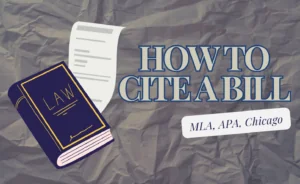So, you’ve hustled through heaps of books, articles, websites, and coffee cups to find that one dissertation that’s the perfect fit for your research. Or maybe even a couple of different ones. And now, you’re wondering how to tip your hat to these fundamental academic works in your paper? Whatever your required style is, be it APA, MLA, or Chicago, this guide has you covered. Let’s see how to give credit where it’s due without turning your brain into alphabet soup.

✅ AI Essay Writer ✅ AI Detector ✅ Plagchecker ✅ Paraphraser
✅ Summarizer ✅ Citation Generator
Citing a Dissertation: The Basics
Alright, let’s get down to the nitty-gritty of why citing a dissertation is more than just a chore you’ve got to check off your list. When you’re pulling all-nighters, drowning in what feels like an endless sea of resources, finding that one dissertation that aligns perfectly with your argument feels like striking gold. While finding a great resource will definitely brighten your paper, it’s necessary to build a bridge between your work and the original research that so much contributed to it.
Citing dissertations the right way helps keep your own work transparent and trustworthy. It lets your readers know where you’re coming from, allowing them to explore the sources that shaped your thinking. Plus, education is like a huge cobweb, where every citation is a thread that connects your work to the broader conversation. It’s your way of joining the dialogue and the community, contributing your voice, and maybe even guiding future researchers who stumble upon your work.
And hey, let’s not forget about avoiding plagiarism. Accurate citation guarantees you’re giving credit where it’s due, keeping your academic integrity shipshape and avoiding any iceberg-sized problems down the line. So, while it might seem like just another task on your to-do list, citing dissertations is actually a vital part of academic work.
 How to Cite How to Cite a Dissertation in APA
How to Cite How to Cite a Dissertation in APA
APA style is super detail-oriented. For dissertations, you’ll start with:
- the author’s last name
- a comma and their initials
- the year of publication in parentheses
- the italicized title of the dissertation and a period.
Finally, you mention it’s a dissertation and the institution that awarded it. Here’s what it looks like:
Lawrence, J. (2012). John Adams: Domestic Affairs (Doctoral dissertation). Ohio University.
In-text, you’ll need the author’s last name and the year, like this: (Lawrence, 2012).
 How to Cite How to Cite a Dissertation in MLA
How to Cite How to Cite a Dissertation in MLA
MLA style is a bit different in terms of the order of the elements, but they remain the same:
- the author’s last name and initials.
- the title of the dissertation.
- the year it was published.
- the academic institution,
- the type of dissertation.
Lawrence, J. John Adams: Domestic Affairs. 2012. Ohio University, Doctoral dissertation.
When you’re referencing this in your text, just use the author’s last name and page number if available, like: (Lawrence 45).
 How to Cite a Dissertation in Chicago
How to Cite a Dissertation in Chicago
Chicago style differs from MLA and APA by adopting a tool for every job, thanks to its two systems of citation: the Notes and Bibliography system (N&B) and the Author-Date system. Depending on what you’re working on, you can choose the one that fits your needs best. Let’s break down how to cite a dissertation in both, complete with examples to keep things crystal clear.
Notes and Bibliography System
If you’re in the humanities (think literature, history, arts), you’ll probably lean towards the N&B system. This system loves its footnotes and endnotes, which is great for adding extra tidbits of info without crowding your main text. When citing a dissertation, your footnote or endnote should include:
- The author’s full name (in regular order, no flipping last and first names here)
- The title of the dissertation in italics
- The kind of thesis (e.g., PhD dissertation)
- The institution awarding the degree
- The year of completion
And, don’t forget, a corresponding bibliography entry that’s a bit more detailed.
Example of a footnote or endnote:
Lawrence, John Adams: Domestic Affairs (PhD diss., Ohio University, 2012).
Bibliography entry:
Lawrence, Jason. John Adams: Domestic Affairs. PhD diss., Ohio University, 2012.
Author-Date System
Now, if you’re more into the sciences or prefer a sleeker, in-text citation method, the Author-Date system will be your choice. This approach tucks the author’s last name and the year of publication neatly within parentheses, right in your text, leading the reader to a reference list at the end with all the juicy details.
When citing a dissertation, your reference list entry should include:
- The author’s last name, followed by a comma and their first name
- The year of publication in parentheses
- The title of the dissertation, which should be italicized
- The descriptor “PhD dissertation” (without quotation marks)
- The institution awarding the degree
In-text citation: (Doe 2023)
Reference list entry:
Lawrence, Jason. 2012. John Adams: Domestic Affairs. PhD dissertation. Ohio University.
Choosing between the Notes and Bibliography system and the Author-Date system in Chicago style comes down to your discipline and personal or publication preference. Either way, you’re making sure your readers can track down that dissertation that illuminated your research, showing respect for the original work and keeping the academic conversation going strong.
Citation can be challenging, but there is a decent and reliable academic solution: explore our Citation Generator for free and solve your formatting issue quickly.
FAQ
Follow us on Reddit for more insights and updates.





Comments (0)
Welcome to A*Help comments!
We’re all about debate and discussion at A*Help.
We value the diverse opinions of users, so you may find points of view that you don’t agree with. And that’s cool. However, there are certain things we’re not OK with: attempts to manipulate our data in any way, for example, or the posting of discriminative, offensive, hateful, or disparaging material.